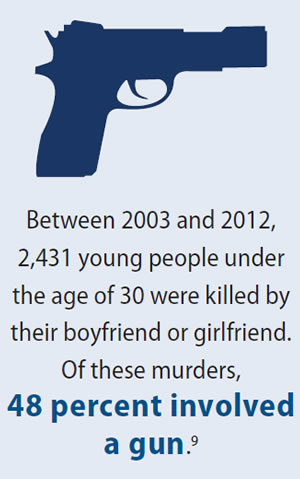Guns pose a particular threat in the hands of domestic abusers.
Guns and domestic violence are a lethal combination – injuring and killing women every day in the United States. A gun is the weapon most commonly used in domestic homicides. In fact, more than three times as many women are murdered by guns used by their husbands or intimate acquaintances than are killed by strangers’ guns, knives or other weapons combined. 1
Contrary to many public perceptions, many women who are murdered are killed not by strangers but by men they know.
- Abused women are five times more likely to be killed by their abuser if the abuser owns a firearm.2
- Domestic violence assaults involving a gun are 12 times more likely to result in death than those involving other weapons or bodily force.3
- More than two-thirds of spouse and ex-spouse homicide victims between 1980 and 2008 were killed with firearms.4
- In 2011, nearly two-thirds of women killed with guns were killed by their intimate partners.5
Dating partner abuse often turns fatal, and this is frequently due to the presence of a gun:
- Between 2003 and 2012, 2,431 young people under the age of 30 were killed by their boyfriend or girlfriend. Of these murders, nearly half involved a gun.
Gun violence in an intimate partner context remains unacceptably high in the United States, and the burden of this violence frequently falls on people in dating relationships. Federal law and many states’ laws do not provide comprehensive protections for victims of dating violence to ensure that their abusers do not have access to guns.
Currently, the following dangerous groups of people are still allowed to purchase and carry guns:
- Individuals convicted of misdemeanor crimes of domestic violence against a current or former dating partner with whom they do not have a child or with whom they have not lived
- Individuals subject to a domestic violence restraining order from the categories of victims listed above
- Individuals convicted of misdemeanor crimes of stalking
Learn More:
- When Men Murder Women: An Analysis of 2002 Homicide Data: Females Murdered by Males in Single Victim/Single
Offender Incidents. 2004. Violence Policy Center. Washington, DC. Retrieved January 9, 2004. http://www.vpc.org/studies/wmmw2004.pdf; http://www.vpc.org/graphics/WMMW03.pdf. - Jacquelyn C. Campbell et al., Risk Factors for Femicide in Abusive Relationships: Results from a Multisite Case Control Study, 93 Am. J. Pub. Health 1089, 1092 (July 2003). http://www.ncbi.nlm.nih.gov/pmc/articles/PMC1447915/
- Linda E. Saltzman, et al., Weapon Involvement and Injury Outcomes in Family and Intimate Assaults, 267 JAMA, 3043-3047 (1992).
- Bureau of Justice Statistics, U.S. Dep’t of Justice, Homicide Trends in the United States, 1980-2008, 20 (Nov. 2011), at http://bjs.gov/content/pub/pdf/htus8008.pdf.
- Violence Policy Center, When Men Murder Women: An Analysis of 2011 Homicide Data 6, (September 2013) at http://www.vpc.org/studies/wmmw2013.pdf.
- Everytown for Gun Safety, Analysis of Recent Mass Shootings 3 (July 2014), at http://everytown.org/documents/2014/10/analysis-of-recent-mass-shootings.pdf
- Susan B. Sorenson et al., Weapons in the Lives of Battered Women, 94 Am. J. Pub. Health 1412, 1413 (2004). http://repository.upenn.edu/cgi/viewcontent.cgi?article=1082&context=spp_papers
- Id. at 1414.

